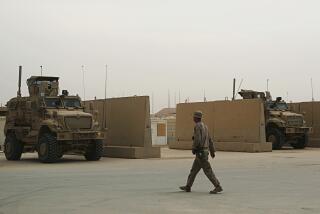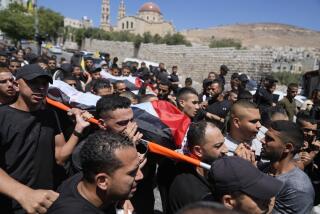U.S. Learns Art of the Deal in Iraq
BAGHDAD â As they struggled to hold together a fragile cease-fire agreement amid sporadic fighting Saturday, American officials were -- once again -- preparing to carry out a peace deal that calls for significant concessions to an adversary they once vowed to crush.
Crucial details of a tentative agreement in the Iraqi city of Najaf were still being hammered out. But as the U.S.-led Coalition Provisional Authority prepares to transfer sovereignty to an interim Iraqi government in a month, it appears eager to reach an accord with militant Shiite Muslim cleric Muqtada Sadr and his militia by following a strategy similar to the one that helped end the bloodshed in the Sunni town of Fallouja.
The compromises reflect a shift away from relying on force to resolve clashes to an emphasis on political negotiation, experts say. âI too am bothered by talking so loudly and backing off,â said retired Maj. Gen. William Nash, a military analyst at the Council on Foreign Relations in Washington. âBut the first rule of getting yourself out of a hole is to stop digging.â
The new search for political compromise carries risks, such as appearing weak militarily and losing credibility in the already skeptical eyes of Iraqis.
For weeks, U.S. forces threatened to âkill or captureâ the young cleric and âcrushâ his Al Mahdi militia, which seized control of key areas in Najaf and other Shiite holy cities nearly two months ago.
On Thursday, the Americans embraced an offer that could allow Sadr to remain free and delay decisions about disbanding his militia or enforcing an arrest warrant against him on charges that he plotted the killing of a rival.
The proposal came nearly a month after Marines in Fallouja dropped their demands that insurgents hand in their weapons and surrender the killers of four U.S. contract workers.
Instead, the military turned over control of the city to an Iraqi force led by a former officer in Saddam Husseinâs army.
In Fallouja and Najaf, American commanders began with similar objectives: to control the territory, disarm rebels and arrest wanted men.
Yet in each case they accepted a deal that protected Iraqis they had called âthugsâ and âterrorists.â
Why the sudden change of heart?
Both sets of negotiations were launched amid growing anxiety that the occupation could unravel as the June 30 hand-over of sovereignty approached.
In pursuing the deals, U.S. officials hoped to end the violence, reduce American casualties and increase stability before the interim Iraqi government took office.
U.S. forces were initially unyielding toward the rebellions in Fallouja and Najaf, sending in thousands of troops to enforce order. American troops quickly discovered that the harder they pushed militarily, the stronger the opposition grew politically.
âBecause of the severe attitude and reaction by the coalition forces and the efforts to suppress the militias militarily, the militias became more influential in terms of public opinion,â said Paul Wilkinson, a professor of international relations at the University of St. Andrews in Scotland.
Before the military closed Sadrâs tiny newspaper in March, the cleric was viewed chiefly as an irritant, a minor Shiite leader who was sometimes ridiculed for having to bus in supporters to listen to his speeches.
The crackdown turned Sadr, whose assassinated father is revered by many Iraqis, into a national symbol of anti-Americanism. His defiant attacks against the occupation struck a chord with thousands of young, disenfranchised Iraqis, who rushed to join his militia. Hundreds, many still in their teens, have fought to their deaths in recent weeks against U.S. forces in Kufa, Najaf and Karbala.
Likewise, in the eyes of many Iraqis, the U.S. attack transformed Fallouja from a fundamentalist enclave tied to Husseinâs regime and stigmatized by the March 31 killing and mutilation of four American civilian contractors into a victim of aggression.
In both cities, the U.S. had little choice but to pull back and search for a political solution.
âIf they had pressed on with an attempt to eradicate the militia or to suppress their opponents, the political price would have been so high it would have made the job of establishing a transitional government almost impossible,â Wilkinson said.
The compromise in Najaf is also a sign that U.S. strategists may have underestimated the frustration of Iraqâs majority Shiite population and overestimated its sectarianism.
âThe coalition made too much of the religious divide,â said Charles Heyman, a senior defense analyst at Janeâs Information Group. âWhether they are Sunnis or Shiites or Kurds, Iraqis have a sense of being Iraqi. If a Middle Eastern country tried to take over the U.S., there would be a groundswell of opinion against them, too. There is much more that bonds us together than keeps us apart.â
Despite deep divisions among Iraqâs Shiites, their political leaders demonstrated a surprising -- if sometimes reluctant -- unity when it came to facing American forces.
âThereâs a common saying in Iraq,â explained one Shiite shopkeeper in Baghdad. âMe and my brother against my cousin. Me and my cousin against the stranger.â
Although other Shiite leaders, including Grand Ayatollah Ali Sistani, frowned on Sadrâs calls to violence and his militiaâs seizure of mosques and shrines, they refused to side with the Americans against him.
âIraqis now feel there is only one enemy against them: the Americans,â said Sheik Ahmed Shibani, a Sadr aide. He said the siege in Najaf backfired by unifying Shiites. âIt has caused the rise of one Shiite leadership.â
Such claims may be premature. Distrust among Shiite factions remains high.
For Americans, the tentative deal in Najaf -- as it was in Fallouja -- is designed in part to reduce casualties, a senior Pentagon official said.
âThe way you avoid casualties is by not fighting,â the official said. âAnd thatâs effectively whatâs going on down there.â That approach has American commanders negotiating with unsavory, âMafia-likeâ characters, the official said.
Under the terms of the deal, Sadr agreed to vacate government facilities and send some armed followers home. In return, the U.S. would pull back to small bases in and around Najaf and Kufa. Eventually, Iraqi police would take over security.
Itâs too soon to know whether the tentative agreement will hold. It is being tested daily by skirmishes between U.S. troops and Sadrâs militia. On Saturday, U.S. forces said they killed Iraqi militiamen who fired rocket-propelled grenades near Najaf, Reuters reported. Heavier fighting Friday left three Iraqis dead and two Americans wounded.
Although the U.S.â exit strategy in Najaf appears similar to the one it pursued in Fallouja, resolving the standoff in the holy city could prove more complicated. As the center of Iraqâs Shiite community and home to historic shrines, Najaf holds great symbolism for about 60% of the population, raising sensitivity about the presence of U.S. troops.
But a withdrawal could leave a security vacuum that could be equally worrisome, particularly if inter-Shiite clashes escalate.
The compromises in Najaf and Fallouja may also carry long-term costs if they enable local leaders to create fiefdoms. That could undercut the authority of the future government in Baghdad and its security forces, possibly threatening to further splinter the country. Already the Kurds exercise virtual autonomy in the north.
In the short term, however, the U.S. may have few options.
âRather than trying to eliminate the factions, it is better at this stage to withdraw and allow Iraqi administration of those cities until the new government is set up,â Wilkinson said.
âEventually the new government is going to have to deal with these people if the country is going to remain in one piece. The danger of breaking into separate enclaves is real. But whatâs important now is to maintain a certain level of stability.â
*
Times staff writer John Hendren in Washington contributed to this report.
More to Read
Sign up for Essential California
The most important California stories and recommendations in your inbox every morning.
You may occasionally receive promotional content from the Los Angeles Times.










